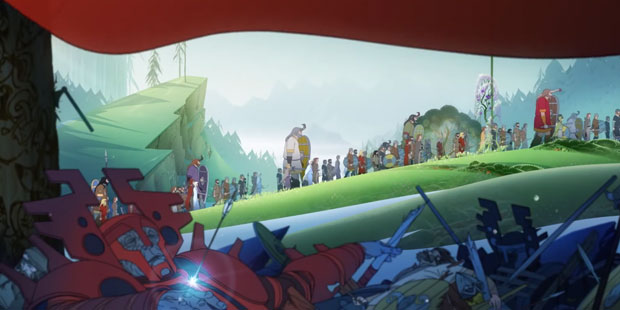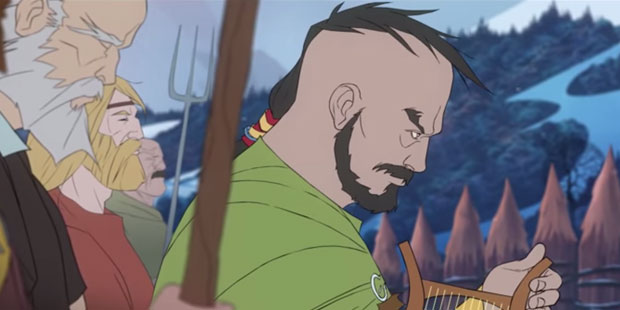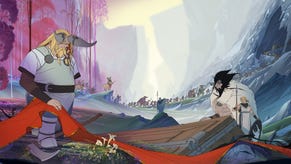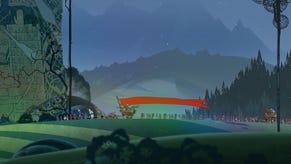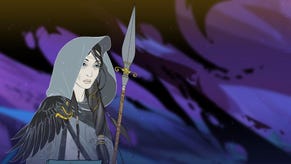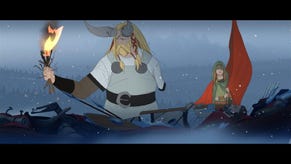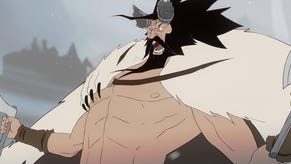The Banner Saga 2: On Combat And Continuity
Tweaking the trilogy
I arrived a few minutes early for a Banner Saga 2 [official site] interview with Stoic's artist Arnie Jorgensen and writer Drew McGee at E3 so I set my bags down and walked over to a vacant demo computer. The game is the second of Stoic's planned trilogy and I've only played half of the first Banner Saga so I was a little cautious – what if there were spoilers?
Curiosity won out and OH GOD THERE WERE SPOILERS!
With that in mind, if you've not played or finished the first game and wish to avoid spoilers just bookmark this for later:
Banner Saga 2 is set several weeks after the first game ends. "There's this battle at the end which you haven't played and I won't ruin it but you pick up from there and you're either Rook or Alette," explains McGee. They're a father and daughter who take up key roles as part of a human caravan. The caravan is seeking safety from the monstrous threat of these stony, roboty Dredge creatures. Rook is a main point-of-view character in the first game but choices made as part of the final battle determine whether this is still true when you hit part two and import your data. If you didn't play part one you pick which of the two you play as.
"Rook has just gone through something devastating or Alette has also gone through something devastating," adds McGee. Which of the two you're playing as changes the challenge a little and alters the expectations of other characters. If it's Alette it's almost like starting over with a new game, needing to prove your worth solo and convince people to follow you. If you're Rook it's more about dealing with grief while living in a society which doesn't have space for that process. "How do you cope with grieving in a society where you should shrug it off but he doesn't? His whole reason for living was to save his daughter," says McGee.
The fallout from part one's conclusion will obviously affect the Saga and change the story in what sound like interesting ways but part twos of any trilogy always feel like they're occupying this weird territory in stories. I approach them almost certain that none of the massive overarching plotlines will be concluded and thus wondering if it'll simply be a few hours of treading water. It's not that interesting things can't happen, but at the back of my mind is the knowledge that the really satisfying, big payoffs likely won't come until the next game. With part twos I often wait until the part three arrives so I can play them without that nagging feeling.
I mention all of this to McGee. "What we're shooting for is you've got the overarching story but each individual game should feel complete," he tells me.
"There's so much to draw on from what was left open in the first game. We want secondary characters to have complete arcs. It's not all about the protagonists. it's about these characters who are interacting with you. All of that hopefully resonates enough with players to make it feel meaty and enjoyable as a second game even if you never played the first one [...] On top of that we also want it to feel seamless as a trilogy so we're juggling a lot of plates there.
"Those elements alone will bolster the story. Obviously we have climactic events that are going to be occurring and you're going to be introduced to the Horseborn - a new race - so all of these elements will make it feel like a new story and not just treading water."
At this point I bring up combat. I own Banner Saga on PC but I had been playing it on tablet during train journeys because it felt like a story I could sink into while travelling. Sometimes fellow travellers would peer over and try to see what I was doing. On one trip I turned my screen to let one of them – a pudgy-handed, grinning toddler – get a better look and try to "help" with a battle. But the tablet is outdated to the point where combat scenes now take minutes to load and so my progress had ground to a halt. I could boot up the PC version but the combat – the idea of repeatedly clearing all those battle boards of foes all over again – was putting me off. It's not that the turn-based combat is bad – far from it – but it is repetitive, the same objective to be achieved over and over. I found that fights just slipped into this mush of actions, none sticking with me as particularly memorable or tense.
"One of the things we've seen a lot in comments is some of the combat felt a little slow, or not diverse enough so that was the number one thing we tackled," says McGee. "No-one seems to have a problem with the type of heroes you can play as, it's the type of enemies you're fighting so we went through and thought where can we spend our budget to diversify that enemy base - give them new abilities, buffs… My whole thing was to give them a culture and really extrapolate on that to bring the Dredge to life."
The team has also dedicated a lot of time to watching Let's Plays of the first game, picking out where players hesitate or pause. "You see where they lose interest - you can hear it in their voice and see it in their mouse clicks," says McGee.
"Now the combat boards are all going to be hand touched. They're going to be scripted to really follow the narrative so it's never going to be this situation where I'm just on a blank board with random spawners. The first battle you fight there, the tutorial, is you come upon this village that's about to be sacked so the whole battleboard emulates that. There's destructible barricades. That wasn't in the first but it really provides a new layer to the strategy."
At this point Jorgensen joins us. He has watched a lot of those Let's Plays and says that the main takeaway from the first game for the team has been the need to work on switching up the combat..
"We're going to have more win scenarios," says Jorgensen. "We're going to have a lot more variation in combat, not just 'kill them all'. John [Watson, the lead programmer] did a whole new toolset for the engine so we can make it more scripted, so we're going to be moving story through the combat."
He goes on to elaborate on what McGee was saying about the tutorial/demo battle. "The whole thing feels a little more cinematic. We have destructibles now so you can put up barricades and have them broken. You can put up urns that are knocked over with coals that come out and affect the battlefield. We're doing everything we can except for we're still not doing height.
"That's something a lot of people bring up but it would break our combat balance. Everything is so finely tuned with archers and they're almost overpowered so if I game them height we're done. I might as well only roll in with archers! Some people think it would make it more fun but it would really just break the game."
Secondary characters have had their roles altered too. "What we used to get for war, it would just say 'Here's how many Dredge, here's how many fighters' and then you go into a fight. It didn't feel very tactical or rewarding. This time it's story based.
"You can get advisors now. In a war they might come up to you and say 'You hold them off for a little while and I'll come in and we'll smash them from the back' or it could change the win scenario or it could say 'Let's toss clansmen at them and run'."
I ask Jorgensen for some examples of those new win conditions. He tells me that they'll be keeping the kill-them-all of the first game for some scenarios but that I can also expect boards where the objective is to kill one enemy in particular, or where you need to make your way from one side to the other. In others you'll need to protect a unit or to survive for a certain number of rounds. The idea is to weave the story and the combat closer together, relating the actions you must perform to the end goal.
He brings up the battle at the end of the demo – the one I left mid-conversation because of the spoilers.
"Before you go into the final battle you have all your heroes and you could tell Bolverk of the Ravens, 'Hey, give us a little help in this one.' You could tell Oddleif 'Hey, defend us with some arrows' or you can tell Griss – one of the big Varl – 'Hey, smash them! Run ahead and smash them.' All three of those things will have an effect on combat so that's what we're talking about too, outside combat and leading into it there's going to be more variables at play."
Then the kicker, "Some of those might wind up killing one of your units. It wouldn't be a Banner Saga game unless you had the ability to choose poorly and kill someone!"
Which brings us to Gil. He's there in this demo build but apparently only about 4% of players have Gil still alive at the end of the first game. There's an achievement for doing so. I suggest that if players make it through the whole trilogy with Gil still breathing they should get a free smoothie or something. I'll confess, it was nudging on lunchtime while the interview was taking place. The suggestion is taken under advisement but McGee adds that it can be an odd thing, realising that some of what you write will only ever be seen by a fraction of the playerbase.
"You get to create these arcs for characters and realise that not a lot of people are going to get it. But when we're at the show next year talking to fans it'd be great to hear people who did get those story arcs and do appreciate it - or even if they don't - the fact that they accessed it because they were playing…"
Before I left the demo, one of the last pearls of wisdom it offered was that I could now send people off to spread reputation on my behalf.
"That was brought about via fan feedback," says McGee. "People were saying at some point your clansmen are a number and if they die it's actually better for you as you're not burning through supplies. We really want to bring the focus back to the caravan. You're not some general of a massive army with renowned heroes or anything. You're a common person who is leading people frantically across a world [that's] breaking, so those people are going to be somewhat self-sufficient. They're not just looking to you for every bit of information.
"We kind of echo that sentiment in a lot of the pop up quests because, hey, you might choose to do something and people are like 'No, we're going to do this anyway'. They have their own minds. in this regard. Clansmen collect food. they go out hunting, they do talk about your heroic deeds - 'We're following this guy or this girl under their banner and she's amazing', so when they get into town the Renown [Renown is the main resource in the game – in the first game it's spent on hero upgrades, supplies and purchasable items] is growing. Whereas fighters are training, working on becoming better fighters."
The differences between the first and second game sound like they're not disruptive but just apply improvements and learnings so I ask whether the team has plans for the whole trilogy to be playable from beginning to end as a single entity with no breaks. "We want it to be that seamless feel so we'd love to have some boxset collector's edition that looks like Tolkien's masterpieces so you should be able to load it and play first to third," says McGee. On that front he notes that it would be "lovely" if they could work out a way to apply these tweaks and improvements retroactively. (That's not a declaration of intent, by the way. Just a 'wouldn't it be nice if...').
They're also having some discussions about eventually making the game fully voiced. That's not an idea that appeals personally as I like the space reading gives for you to add your own ideas to characters. I think I'd be really thrown off if Alette didn't sound like *my* Alette. "To a degree it's grass is greener on the other side," says McGee. "There's something about reading it and putting your own voices to the characters."
The Banner Saga 2 is intended for release in the winter. That suits me fine as I found the best way to experience the game was curled up in a duvet nest while hiding from the bone-chilling damp of British winter.




